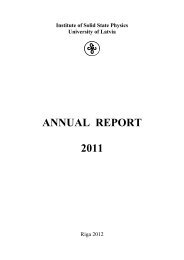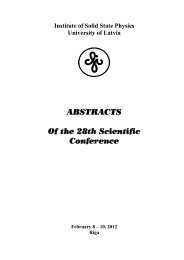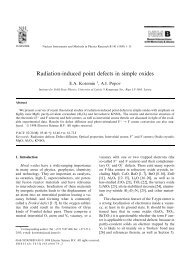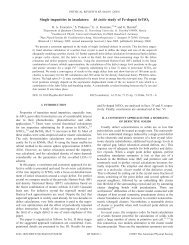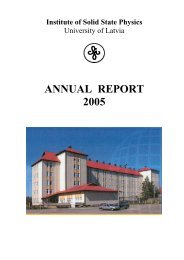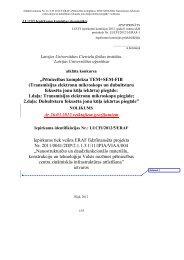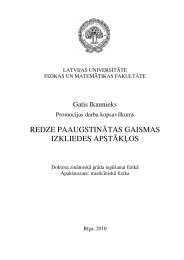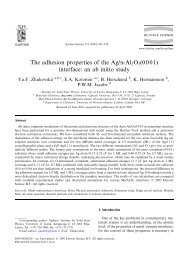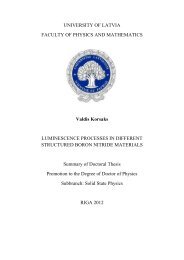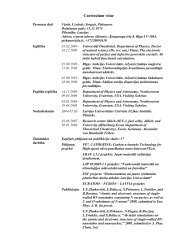Annual Report 2012 - Latvijas Universitātes Cietvielu fizikas institūts
Annual Report 2012 - Latvijas Universitātes Cietvielu fizikas institūts
Annual Report 2012 - Latvijas Universitātes Cietvielu fizikas institūts
You also want an ePaper? Increase the reach of your titles
YUMPU automatically turns print PDFs into web optimized ePapers that Google loves.
The oxygen incorporation energy for the GB is smaller than for both surfaces, but<br />
remains still negative, even at 700 K. Lastly, the O solution energies (incorporating<br />
also N vacancy formation cost) in all three cases are predicted to be very close and<br />
negative (-2.5 eV), thus the oxidation process is energetically favorable at all studied<br />
temperatures that explains fast oxidation of UN on air.<br />
FIRST PRINCPLES SIMULATIONS OF Y 2 O 3 CLUSTER GROWTH<br />
IN ODS STEELS<br />
A. Gopejenko, Yu.F. Zhukovskii, Yu.A. Mastrikov, E.A. Kotomin,<br />
P.V. Vladimirov, A. Möslang (Institut für Angewandte Chemie, KIT, Karlsruhe,<br />
Germany)<br />
V.A. Borodin (Research Center Kurchatov Institute, Moscow, Russia)<br />
Reduced activation ferritic-martensitic steels (RAFM) strengthened by yttria<br />
precipitates are promising structure materials for future fusion and advanced fission<br />
reactors. Oxide dispersion strengthened (ODS) particles hinder dislocation motion<br />
effectively resulting in higher strength and better high-temperature creep resistance of<br />
ODS steels in comparison to basic materials. Implementation of ODS materials widen<br />
the operating temperature as compared to conventional RAFM steels as well as they are<br />
more radiation resistant. The size and spatial distribution of ODS nanoparticles<br />
significantly affect both mechanical properties and radiation resistance. Unfortunately<br />
the mechanism of the ODS particle formation is not completely understood.<br />
In close collaboration with partners from the Karsruhe Institute of Technology<br />
(Germany) and from the Kurchatov Institute, Moscow (Russia), we performed a<br />
computer modelling of the ODS particle formation process. Experimental studies,<br />
performed at the KIT, show that a significant part of Y and O atoms is found in the steel<br />
matrix in the concentrations exceed their equilibrium solubility after milling. Depending<br />
on Cr concentration, during the cooling process steel may or may not go through the<br />
phase transformation. Therefore, we consider the ODS particle formation process in<br />
both- fcc and bcc- phases. There is a significant lattice mismatch between the fcc/bcc-Fe<br />
and the bixbite-type Y 2 O 3 . At the very initial steps of the ODS particle formation<br />
process, space, necessary for creation the bixbite-type bonds within the iron matrix,<br />
could be provided by vacancies.<br />
For the fcc phase, we found the most stable configuration of three vacancies and<br />
single Y atom. The lowest energy was obtained for the systems with the solute atom,<br />
located at the centre of the cluster. For the bcc phase we investigated the growth of<br />
vacancy cluster. The largest modelled cluster contained nine vacancies. The same<br />
process was repeated with a single Y atom. For all systems the binding energy increases<br />
with the number of vacancies, except adding the seventh vacancy. The interaction<br />
between Y atom, stabilized by divacancy with solute Y Fe atom, at close distances is<br />
attractive. The largest attraction energies (1-1.1eV) are obtained for the systems with<br />
obtuse V Fe -Y i -V Fe -Y i -V Fe angles. Two Y atoms, each stabilized by divacancy, attract to<br />
one another. For the first three NN spheres vacancies overlap. Without overlapping, for<br />
the nearest coordination spheres binding energy is about 1.3 eV.<br />
The results of the calculations on both phases clearly show that Fe-vacancies play a<br />
major role in binding between defects. It was found for the fcc phase, that binding<br />
energy between Fe-vacancies significantly increases in the case of four vacancies in<br />
comparison to the configurations with two or three Fe vacancies. The largest binding<br />
energies were found for the configurations with a single Y atom and several vacancies.<br />
The binding energies for the configuration between two Y atoms and vacancy increase<br />
67



